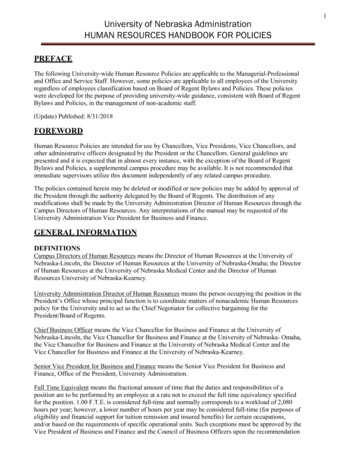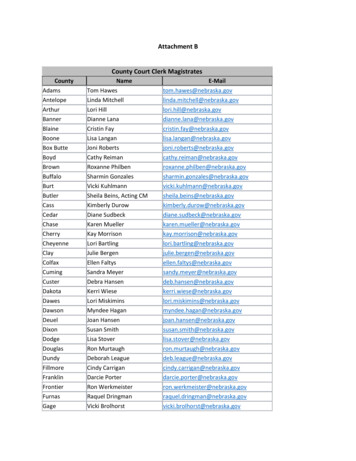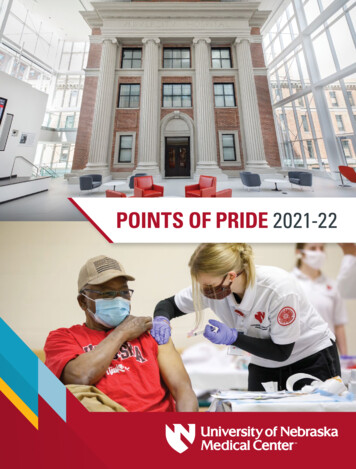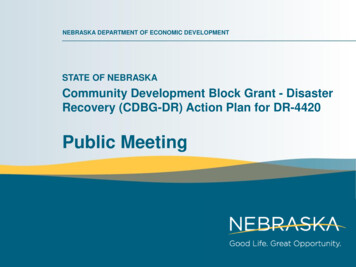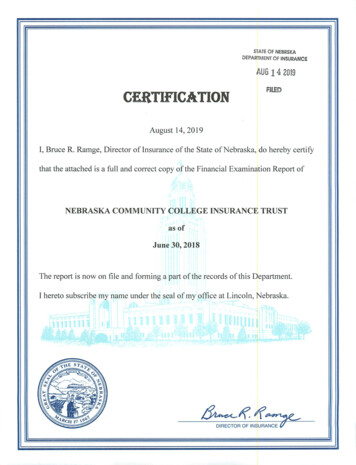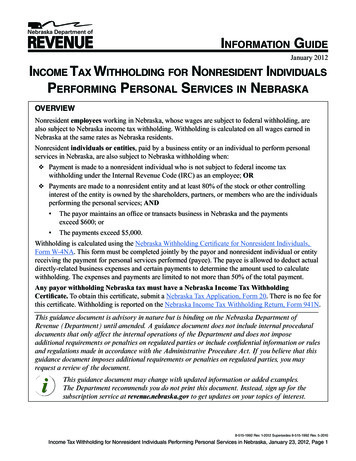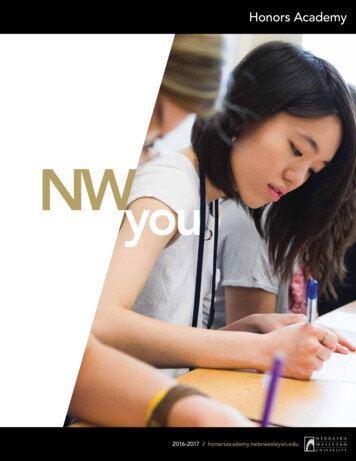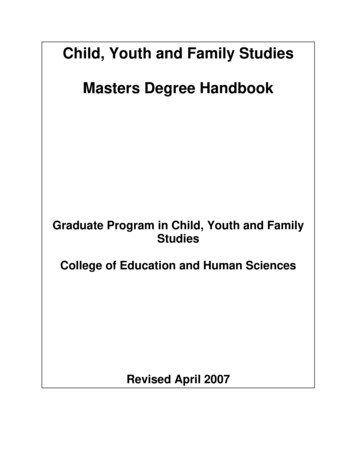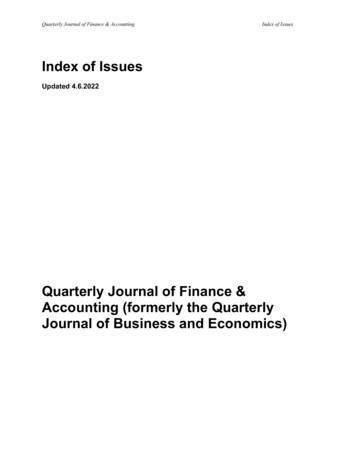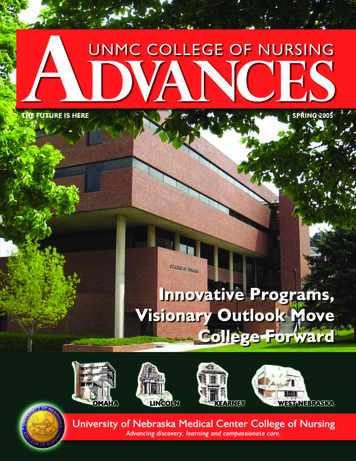
Transcription
Table of ContentsInnovative Programs,Visionary Outlook MoveCollege ForwardFeatures2ADVANCES4An Ambitious Plan Guides theCollege of Nursing6Rural Research Project HasLasting Impact10Compassionate Care RecognizedThrough Generous Donation12Accelerated Programs Fill Two Needs:Produce More Nurses and Nursing Faculty15Pictures, Uniforms Other MemorabiliaChronicle the History of theCollege of Nursing16Donor Finds Satisfaction in Giving18Donors Who Make A Difference19Funded Research for 2004491016SPRING 2005
TUNMC College of NursingAdvances is published annuallyby the University of NebraskaMedical Center College of Nursing.Permission is granted to reprint anywritten materials herein, providedproper credit is given.UNMC College of NursingAdvances985330 Nebraska Medical CenterOmaha, NE, 68198-5330For address changes,E-mail: LaDonna Tworek atltworek@unmc.eduOr call UNMC Alumni Affairs, (402)559-4354 or (888) 725-8664Dean: Virginia Tilden, D.N.Sc.Designer: Joe EdwardsContributors: Vicky Cerino, LisaSpellmanPhotographers: James Colburn,Stephen Smith, Darin Epperly, GlenJohnsYou may also read issues ofAdvances online at: www.unmc.edu/NursingInnovative Programs, VisionaryOutlook Move College Forwardhe UNMC College of Nursing advances at an impressive pace.With a new vision in hand and several major accomplishments under our belt thecollege is poised to become a leader among peer institutions.A quick look at last year shows this potential.In 2004 the College of Nursing ranked 22nd in NIH dollars out of the 98 schools ofnursing in the country receiving NIH funding forresearch.US News and World Report ranked thecollege’s master’s degree in nursing at 39th out ofthe 260 master’s programs in the country.At the same time, enrollment increased animpressive 21.5 percent with the average admittingGPA at 3.55, the highest in over a decade.Clearly the faculty, staff and students at theCollege of Nursing have raised the bar.To capitalize on this momentum we have created a long-range plan with goals set for the years2010 and 2015.This plan includes input from the more than200 faculty and staff at the college and identifies twooverarching goals.By the year 2010 and beyond, the UNMCCollege of Nursing will be: Positioned in the top 10 percent of peer institution schools of nursing in the country. Widely recognized for the use of technology inadvancing the missions of education, researchand practice.Virginia P. Tilden, D.N.Sc.These goals are ambitious but not out of ourDean of the UNMC College of Nursingreach.We are committed to providing our studentsthe best education and our faculty more research and scholarship opportunities, and to serving the needs of Nebraskans through our clinical practices.We have implemented two programs that accelerate the learning process for nursingstudents with the goal of moving more nurses and nurse faculty to where they are neededmost: into clinical practice and into the classroom.The accelerated B.S.N. offers persons who have a bachelor’s degree in other fields toearn a bachelor of science in nursing in 12 months.The fast-track Ph.D. program enables those nurses who want to teach earn theirdoctoral degree more quickly, thus accelerating their transition to the teaching role.There are 20 students enrolled in the accelerated B.S.N. program and the first cohort offast-track Ph.D. students will begin classes this fall.It is an exciting time at the College of Nursing, one that deserves a publication thatreflects this enthusiasm.I hope you enjoy the new ADVANCES and news of this dynamic College.Best to all,Virginia Tilden, D.N.Sc.WWW.UNMC.EDU/NURSINGADVANCES3
An Ambitious Plan Guidesthe College of Nursing“ProactiveTplanning allowsus to create apreferred futurein a timeof greatopportunity.”Virginia TildenDean of the University of NebraskaMedical Center College of Nursing4ADVANCESStory by Lisa Spellmanhe goals might seem lofty: Rank in the top 10 percent of peerinstitutions in the country by 2010. Become a recognized leader in the useof technology to advance the missionsof education, research and practice.But don’t tell Virginia Tilden, D.N.Sc.,R.N., F.A.A.N., dean of the Universityof Nebraska Medical Center College ofNursing, that they can’t be reached.“The people of Nebraska deservenothing less from their UNMC College ofNursing,” said Dr. Tilden. “And we can doit. We have the capacity, the training, theknowledge and the drive to achieve thesethings.”In fact, she says, the College of Nursinghas already made several major accomplishments.“US News and World Report rankedthe college’s masters degree in nursing at39th out of the 260 masters programs in thecountry in 2004,” said Dr. Tilden. “We areranked 22nd in National Institutes of Healthresearch dollars out of 98 schools of nursingin the country and we offer 68 of ourcourses to students in 88 different geographic sites, including Jordan and Armenia,using distance technology.”All of the College’s goals are outlinedin a 103-page document Dr. Tilden calls theCollege of Nursing Long Range Plan.It took 9 months to complete andincludes input from all of the more than 200faculty and staff at the College of Nursing,she said.The goals, which are targeted to theyears 2010 and 2015, are based on ananalysis of key trends identified by futurists asbeing relevant to long range planning.These include: societal trends, healthcare trends, and trends in the health professions.Information technology, changingdemographics, the development of newtherapies and techniques and competencybased education, said Dr. Tilden, are justa few of the trends that were taken intoconsideration.“We believe that proactive planning willallow us to create a preferred future in a timeof great opportunity, great societal changeand rapidly advancing technology for education, research and health care,” she said.In order to meet the overall long-rangegoals the college identified six strategic areasto consider: Educating professional nurses for thefuture. Expanding research and scholarship. Expanding faculty practices and community partnerships. Inviting international nursing educationopportunities. Harnessing future technology as a toolfor education, research and practice. Addressing impending workforce shortages in nursing education.“The College considered its opportunities, challenges, limitations and strengths ineach of these areas,” Dr. Tilden said.It is predicted that the health care environment of 2010 will be characterized byincreasingly complex care delivery systems,greater patient acuity and extended longevitymarked by long periods of living with chronicillness.Nurses must be prepared to meet theseand future unforeseen demands, challenging educational programs to be ever morevisionary, efficient, and effective.While the college’s current baccalaureate program is well positioned with a strongclinical curriculum that uses innovativedelivery systems, Dr. Tilden said, it can bestrengthened by increasing the emphasison evidence based practice, clinical decisionmaking, and interdisciplinary team practice.“My vision for the college is simple: excellent programs, excellent graduates, and anSPRING 2005
engaged, spirited faculty and staff energizedby delivering the two,” said Dr. Tilden.In order for that to happen researchand scholarship must also be expanded.“Robust growth in research lendsstrength to the Ph.D. and planned postdoctoral program,” she said. “Students andfellows are attracted to programs wherefaculty are nationally known for theirresearch, which in turn feeds growth in theeducation arena. In addition, the Collegeshoulders its responsibility in advancing theUniversity’s research agenda and in delivering the “high impact” nursing science neededto advance the public’s health. That is whyit is important that the College of Nursingmove into the top 10 schools of nursing inNIH funding.”In 2004 the college created fiveresearch-intensive faculty positions and isactively recruiting funded researchers toachieve this objective.Another important aspect of meetingthe goals of the long-range plan is to harnessfuture technology that will support education, research, practice, and administrativeoperations of the college.“Faculty and staff have already acquiredmuch experience and expertise in this areahaving developed the first of the University’sdistance education program in the 1970s,”said Dr. Tilden. “We can capitalize on thisexisting strength by developing and augmenting resources in this area.In the next 10 years distance educationprograms will not only increase, she said,but be demanded by students who havegrown up in digital environments and expectlearning experiences using technology, suchas clinical simulations.“Our plan is ambitious, energetic andvisionary,” said Dr. Tilden. “It has to be inorder to meet future societal demands,educate nurses who are prepared to meetthose demands and become one of thepremier nursing schools in the country.”College of Nursing Executive Council. Back row – left to right: Larry Hewitt, Peggy Wilson, Carol Pullen, Sheila Ryan,Bernice Yates, Bob Mancuso, Catherine Bevil. Second row – left to right: Kate Fiandt, Polly Hulme, Cheryl Thompson, Patti Carstens, LaniZimmerman, Catherine Todero. Front row – left to right: Martha Foxall, LaDonna Tworek, Virginia Tilden, Susan Noble Walker. Insetpictures: top, Gloria Gross, bottom, Judy Billings.WWW.UNMC.EDU/NURSINGADVANCES5
Rural Research ProjectHas Lasting ImpactEncouraging a person to eat healthier and increase their physicalactivity takes more than just lip service. Participants are more successfulwhen they are shown, through examples, how to eat healthier, to getmore exercise and incorporate those changes into their lifestyle.Susan Noble Walker, Ed.D., R.N., credits the work of her interdisciplinaryteam for the success of her research study. Pictured, from left to right,are: Maureen Oberdorfer, Dr. Walker and Matthew Rutledge.NStory by Lisa Spellmanot all of the 220 women from ruralNebraska enrolled in Susan NobleWalker’s research project, Wellness forWomen, have met goals for incorporatinghealthy eating and physical activity into theirlifestyle, but many have made extensivechanges over the past two years.“On average, the participants have increased their level of physical activity and areeating healthier,” said Susan Noble Walker,Ed.D., R.N., professor and chair of theDepartment of Gerontological, Psychosocialand Community Health Nursing at theUniversity of Nebraska Medical Center.Dr. Walker is the principal investigatorof the research project, which began in6ADVANCES2001 when she received a 1.6 milliongrant from the National Institute of NursingResearch, National Institutes of Health.She is joined by an interdisciplinaryteam of investigators including PatriciaHageman, Ph.D., professor and directorof Physical Therapy Education at UNMC;Linda Boeckner, Ph.D., professor at theUniversity of Nebraska-Lincoln Departmentof Nutrition and Health Sciences; and CarolPullen, Ed.D., R.N., professor and assistantdean for Distance Education and Technologyin the UNMC College of Nursing. Projectstaff includes Maureen Oberdorfer, M.P.A.,project coordinator, Matthew Rutledge,M.A., instructional technologist, and researchnurses Cathy Vasko, B.S.N. in Scottsbluffand Dawn Garcia, B.S.N. in Norfolk. Bothresearch nurses are graduates of the UNMCCollege of Nursing.The goal of the research project is toevaluate the effectiveness of an interventionprogram that encourages midlife and olderwomen living in rural areas to adopt thehealth-related behaviors of healthy eatingand physical activity.“The study is designed so the womencould work toward their lifestyle changegoals at home rather than in organizedgroups,” Dr. Walker said.Two groups of 110 women, ages 50to 69, were recruited from Scottsbluff andNorfolk by random digit dialing conductedby the University of Nebraska-LincolnBureau of Sociological Research. One groupreceived tailored newsletters and the otherstandard newsletters.The intervention lasted for one yearwith participants receiving newsletters everytwo weeks for six months, then only once amonth.All of the women came to the researchSPRING 2005
Participant TakesStudy to Heartoffice in their community every threemonths in the first year of the study andevery six months in the second year. Theoffices were located at the CooperativeExtension Office in Scottsbluff and NortheastCommunity College in Norfolk.Follow-up visits were then scheduledfor 18 and 24 months to evaluate whetheror not the women were able to sustain anypositive behavior changes.Participants were given a pedometerwhen they started the study, and a researchnurse helped them to complete an assessment of activity and eating patterns on acomputer at each office visit. The nursesalso assessed the women’s fitness level anddrew blood for cholesterol levels.The data was used to create a tailorednewsletter that gave specific advice to eachparticipant selected to be in the tailoredgroup. The advice was based on participants’answers to various questions.The remaining group of participantsreceived a standard newsletter that gavehelpful tips on healthy eating, exercising andbasic facts about fruits and vegetables, butwas not based on each woman’s data.“Feedback is motivating,” said Dr.Walker. “We hoped that by providing detailed advice concerning areas in which studygroup participants needed to make changesin activity and eating, it would prompt themto make those changes.”For example, she said, if a participant’sdata indicated that she ate fewer than therecommended minimum of two servings offruit a day, that person’s tailored newsletterwould have a paragraph explaining how toincorporate more fruit into her diet, giveexamples of what a serving size is as well asinclude a recipe.“We not only told women what theyshould do, but how to do it and how toovercome barriers and get greater interpersonal support from friends and family,” Dr.Walker said.The women also were educated aboutStory by Lisa SpellmanBertha Fuentes’ participation in the Wellness for Women researchproject couldn’t have come at a better time.“I received a letter in late 2002 from the (University of NebraskaMedical Center) college of nursing that told about this study for women,”said Fuentes. “I was curious and called.”Fortunately for theGering, Neb., resident,the research project wasexactly what she needed.Earlier that yearher husband underwentquadruple heart bypasssurgery and Fuentes hadlearned recently that shehad Type II diabetes.“For the health of myhusband and myself I hadto learn how to preparefood in a way that wasdifferent than the way Ihad prepared food for 46years,” Fuentes said.This is exactly whatthe research project,Research study participant, Bertha Fuentes, of Gering,spearheaded by SusanNeb., pictured with research nurse Cathy Vasko, B.S.N.Noble Walker, Ed.D.,Professor and chairof the Department ofGerontological, Psychosocial and Community Health Nursing at UNMCaimed to do.The two main goals of the Wellness for Women research project – toencourage rural women ages 50 to 69 to eat healthier and be more physically active – was just what the doctor ordered.“I learned how to prepare food that was fat and salt free,” said Fuentes.“I also learned how to read food labels, how to make better food choicesand the importance of making these changes.”The newsletters provided recipe ideas, tips on cooking and the value ofexercise.“Steaks, pork chops, chicken, fish – I use to pan-fry everything,” saidFuentes. “Now I broil or bake a lot more.”She also walks six miles every day of the week, except Sundays.“I have lost over 20 pounds in one year,” said Fuentes. “My husband’strygliceride level is at 72, and I am able to manage my diabetes muchbetter.”(continued on page 8)WWW.UNMC.EDU/NURSINGADVANCES7
Pat Hageman, Ph.D.Research ProjectProduces Positive Results(continued from page 7)how much exercise they need every daybased upon national guidelines, which recommends at least 30 minutes of moderateor greater intensity exercise.“We told the women how fast to walkin order to meet the national physical activity guidelines,” said Dr. Walker. “The ideabehind moderate physical activity is thatyou are using most of the major muscles inyour body, giving you a sensation of beingwarm.”Each participant’s progress was measured not only by their reports of their ownbehavior but also by biological markers,such as cholesterol levels, fitness level andweight.So far, all of the women have completed 18 months in the study, said Dr.Walker, and a few have completed theentire 24 months. Some made few changesand some surpassed expectations.“One woman diagnosed with type IIdiabetes has lost 10 percent of her body fatand was able to go off of her medications,”said Maureen Oberdorfer.Oberdorfer said the feedback theresearch team has received thus far hasbeen extremely positive.“Most of the women have said thatthey have learned a lot about how to eatand the importance of daily physical activ-8ADVANCESCarol Pullen, Ed.D., R.N.ity,” she said.Many of the women chose walkingas a way to increase their level of physicalactivity, she said.In addition, all of the women weregiven resistance bands and an instructionalvideotape for strength training developedby the team, and encouraged to do thoseexercises for 30 minutes, two to threetimes each week.In order to ensure the success ofthe research project, Dr. Walker and hercolleagues met with a community advisorycouncil in each geographic area.Dr. Walker said the advisory councilacted as consultants and their input wasinvaluable in making sure the research teamhad realistic expectations for the participants.“We relied on the advisory council torecommend locations where the participants could go to exercise, especially duringthe winter months,” Dr. Walker said.One of the many tips the advisorycouncil suggested was that some local highschools be asked to open their gym afterhours so that participants could go there towalk.“Our hope is that long after the studyends all of the participants will continue tobe physically active and eat healthier,” shesaid.Dr. Walker said that rural womenwere targeted for the research projectbecause they have higher rates of obesityLinda Boeckner, Ph.D.and chronic illnesses than their urbancounterparts.“National data show that rural womenare more sedentary than urban, yet areless likely to receive counseling from theirhealth care providers on the importance ofmaintaining a healthy lifestyle,” Dr. Walkersaid.Dr. Walker chose women betweenthe ages of 50 and 69 because this isthe time when a woman’s health risksincrease.“After menopause women are atrisk for such chronic diseases as diabetes,osteoporosis and cardiovascular disease,”she said. “Many of these diseases arepreventable or can at least be delayed byhealthy eating and daily moderately intensephysical activity.”SPRING 2005
Winside, Neb. Resident Inspiredto Live Healthier LifestyleStory by Lisa SpellmanWhen Carol Brugger was given apedometer upon enrolling in the Wellnessfor Women study and told she neededto walk at least 10,000 steps a day, shethought “this will be easy.”Living on a farm in Winside, Neb.,Brugger led a very busy and active life, orso she thought.“I averaged 3,500 steps a day,” shesaid. “I found out that even though I liveon a farm and work I would still need toget a walk in.”Brugger also discovered the importance of another recommendation thathealth care providers often make: seeyour doctor for preventive care.But before enrolling in the studyin 2002, Brugger was like many ruralwomen who didn’t go to the doctorunless they were ill.Winside resident Carol“I have always been relativelyBrugger with researchhealthy,” she said. “There was no need to nurse Dawn Garcia,go to the doctor unless I was sick.”B.S.N.Brugger changed her mind whenafter her first visit with research nurse, Dawn Garcia, B.S.N., atthe clinic in Norfolk, Neb. During that visit Brugger found out thatshe was teetering on the edge of high cholesterol and high bloodpressure.Surprised, Brugger became actively involved in improvingher health through diet and exercise.“It hasn’t been easy,” she said. “I love sweets. Every day myhusband would come in for a mid-morning and an afternoonsnack, usually something sweet that I baked. Naturally I wouldjoin him but I’ve had to be strict and tell myself I can’t have that.”Brugger also began walking with her daughter at least threetimes a week.“It would take an hour and 15 minutes to walk 3½ miles,now it only takes us 55 minutes,” she said.Her efforts have paid off, said Brugger, who’s now in thenormal range for cholesterol and blood pressure.But cutting down on sweets and walking more were just afew of the changes Brugger made.She now cooks with less salt and grills her meat instead offrying it.Perhaps the most eye-opening information Brugger learnedwas about serving sizes.“I ate way too large of portions,” she said.WWW.UNMC.EDU/NURSINGADVANCES9
KCompassionate Care RecognizedThrough Generous DonationStory by Vicky Cerinoen Morehead was somoved by the nursing carehe received at UNMC years ago that hedonated 1.75 million toward nursing careto the UNMC College of Nursing.On Feb. 3, the UNMC College ofNursing celebrated the opening of theMorehead Center for Nursing Practice,which will benefit people across the state.Morehead, who died in 2000, was aUniversity of Nebraska-Lincoln alumnusand former Lincoln and Omaha automobile dealer. He served as a University ofNebraska Foundation trustee and was alongtime supporter of university athletics. Hebegan supporting UNMC and the Collegeof Nursing in 1988 after receiving care atthe former University Hospital, now TheNebraska Medical Center.The Morehead Center for NursingPractice will provide an infrastructure for thecoordination, support and development offaculty nursing practices, said Kathryn Fiandt,D.N.Sc., associate professor of nursing andinterim director of the center. Housed inOmaha, it will focus on improving the qualityof patient care through education, researchand outreach to the underserved.Faculty nursing practices are contractedservices for health care provided by nursingfaculty typically in community settings. Thepractices include a variety of health servicessuch as primary care, health promotion,helping vulnerable populations gain access tohealth services, and involvement and evaluation of community health projects.Some services are provided throughthe college’s nursing centers, which includethe Panhandle Hispanic/Native AmericanDiabetes Outreach Clinic in Scottsbluff, theSenior Health Promotion Center in Lincoln,the Family Health Care Center in Omahaand the Cosmopolitan-UNMC College ofNursing Mobile Nursing Center.About 25 percent of college faculty havenursing practices, Dr. Fiandt said.“The Morehead Center for Nursing10ADVANCESPractice will help us coordinate our nursingpractices, expand our activities, negotiatecontracts and market our services,” Dr.Fiandt said. “We don’t want to give up ourindigent care, so we need profit centers tosubsidize them, all the while improving careand increasing access. Up until now, thefaculty has had to do it on their own.We will have the opportunity to reallymake an impact on patient care in ways wehaven’t been able to do before. Nurses inacademia are leaders in terms of evolvingKen Morehead’s neice and nephew attendedthe grand opening of the Morehead Centerfor Nursing Practice. Pictured from left toright are: Marc Morehead, Virginia Tilden,dean of the UNMC College of Nursing andKristine Hansen-Cain, R.N., M.S.nursing practice. In education, we have todo research to improve patient care - thentake research-based knowledge and apply itin practice.”An increase in faculty nursing practiceswill enable the college to hire more facultymembers to teach. Currently, the collegedoesn’t have enough faculty or space toaccept all the qualified students who apply toits undergraduate programs across the state.Virginia Tilden, D.N.Sc., dean of theUNMC College of Nursing, said the gift willmake a difference in the lives of patients.“Nurses help people stay well longer andmaximize their quality of life once illnessbefalls them,” she said. “Nursing truly is thescience of caring for people.”Drs. Tilden and Fiandt say college facultyare involved nationally in developing newnursing standards. They see the center as away to help position the college in becominga national leader in academic nursing practicemodels.“The faculty use creative, innovative models to deliver care to vulnerablepopulations and have been forward-thinkingin incorporating nursing practice into theirworkload. The center will enable the collegeto achieve many of its ambitious goals in thepursuit of nursing excellence,” Dr. Tildensaid.Gloria Gross, Ph.D., R.N., assistantdean, UNMC College of Nursing WestNebraska Division, said the center is a boonfor faculty and nurses in western Nebraskabecause it provides clinical services that arebased on strong research and that workwell. “We will be able to have a databasefor unified reports which will help us obtaingrant funding for our clinical enterprises,” shesaid. “The faculty are especially interested inways to promote publications related to theirclinical work.”Kristine Hansen-Cain, R.N., M.S., theniece of Morehead, said her uncle alwayswas complimentary about the nursing carehe received during his lifetime. “I believehe intuitively felt nurses were undervaluedfor the important services and care theyprovided across many different health caresettings,” she said. “From a business perspective, he would be very pleased to know hisdonation will make a positive impact on thecommunity and Nebraska in particular.”The Morehead gift also enabled the college to establish the Kenneth E. MoreheadChair in Nursing to help recruit an outstanding scholar in clinical research.A veteran of the Korean War, Moreheadbuilt a prosperous automobile dealershipwith locations in Falls City, Beatrice, Lincoln,Omaha and Kansas City, Mo. He was oneof nine members and three generations ofthe Morehead family to graduate from theUniversity of Nebraska. A longtime residentof Falls City, he was the grandson of formerNebraska Gov. John Henry Morehead.SPRING 2005
College of Nursing Alumni Reunion Set for June 4Please join us for the UNMC College of Nursing Silent Auction on Friday, June 3 and the Alumni Reunion on Saturday, June 4. Pleasecomplete the form below and mail it to UNMC College of Nursing Alumni Association, 985200 Nebraska Medical Center, Omaha,Nebraska 68198-5200 or fax it to (402)559-8956. You can also register online at www.unmc.edu/alumni.A silent auction will be held Friday, June 3 from 9 a.m. - 3 p.m. in the Durham Outpatient Center West atrium. Proceeds benefit theCollege of Nursing Alumni Association. Auction items include a 4-night cabin stay in the Black Hills; a 7-10 night stay in a house on LakeCushman in Hoodsport, Washington; gift certificates for restaurants; hotel overnight stays; tickets to Omaha area attractions and sportingevents; stethoscope; uniform shop gift certificates; and much more. Go to www.unmc.edu/alumni for a list of auction items.Reunion Schedule:9 a.m.9:30 a.m.10:30 a.m.11:30 a.m.Noon1:30 - 2 p.m.2 - 3 p.m.2 - 4:45 p.m.Registration (coffee cake and coffee available)Annual Meeting (If the annual meeting ends early, we wil begin taking the class photos).Welcome by Minnie Thornton, GND, BSN, ’55, ’58, Alumni Association PresidentClass Photo SessionLunch Buffet Welcome and Comments by Virginia Tilden, DNSc, RN, FAAN,Dean, UNMC College of Nursing,“UNMC College of Nursing’s Agenda of Excellence” Introduction of Honor Classes Presentation to the Class of 1955 Presentation by the Class of 1965 2005 Alumnus Awards Keynote Speaker Ada Lindsey, PhD, RN,“Vision of the College of Nursing History Museum”BreakCampus shuttle and walking tourGrand Opening of the College of Nursing and Alumni History Museum,Enjoy tours of the history museum and a reception in the College of Nursing CommonsPlease RSVP by May 26. No refunds after May 27.Please Print Name for nametag:First Name Maiden Last Class YearAddress City State ZipPhone E-mailSpouse/Guest’s NameCheck the following:CONAA Member/Faculty:CONAA Non-Member/Spouse/Guest:New Graduate (Dec. 2004 and May 2005)/Student(Cost of event pays for expenses for entire event, not just your lunch). 30/person 40/person 15/personI would like to order a reunion class photo. 15.50(includes photo and postage)/photoTotal Amount Enclosed:I will go on the shuttle and walking tourI will attend the Grand Opening of the History Museum and reception Make check payable toCONAA or charge my:VisaMasterardDiscover Card Number (# of people)(# of people)Exp. DateSignatureYou can also register online at www.unmc.edu/alumni or fax your response to (402)559-8956.WWW.UNMC.EDU/NURSINGADVANCES 11
Accelerated Programs Fill Two Needs:TStory by Lisa Spellmanhe United States is a nation in needof nurses.This shortage has Colleges of Nursingacross the country scrambling to find waysto alleviate the problem before it becomesan epidemic.The simple solution – get moreundergraduate students to pursue a careerin nursing –seems easy enough. But thereality is many nursing colleges are facing ashortage of their own.“To fix the nursing shortage you haveto produce more nurses, to produce morenurses you have to have more faculty,” saidMargaret Wilson, Ph.D., B.S.N., associatedean for graduate programs at the Universityof Nebraska Medical Center College ofNursing.It’s a vicious cycle that UNMC’s Collegeof Nursing has taken head-on, said Dr.Wilson.Last year, the College of Nursing beganoffering two programs that accelerate thelearning process for nursing students. Thegoal is to get more nursing faculty andnurses where they a
Medical Center College of Nursing. Permission is granted to reprint any written materials herein, provided proper credit is given. UNMC College of Nursing Advances 985330 Nebraska Medical Center Omaha, NE, 68198-5330 For address changes, E-mail: LaDonna Tworek at ltworek@unmc.edu Or call UNMC Alumni Affairs, (402) 559-4354 or (888) 725-8664
